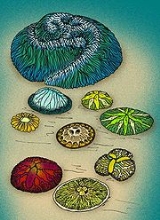
Trilobozoa
Encyclopedia
Trilobozoa is an extinct taxon
of organisms which displayed tri-radial symmetry. Trilobozoans were most dominant during the Ediacaran
period — prior to the Cambrian explosion
of modern life forms.
The taxonomic affinities of this groups are open to debate. Ivantsov and Fedonkin (2002) place them among the cnidarians. They reasoned that since the conulate Vendoconularia
exhibited six-fold symmetry, the conularids — then regarded as a sister group to the scyphozoan cnidarians — must be nested within the trilobozoa, making the trilobozoan group part of the cnidarian phylum.
The most primitive trilobozoans were disk-shaped, typified by Tribrachidium
. Through comparisons with the other discoidal trilobozoans, it appears the different "arm" patterns on each genus/species occurred due to growth arresting or progressing at different stages of developmental growth.
The more advanced, and much longer-lasting, trilobozoans were cone-shaped, as typified by the long-lived genus Conularia
, and had shell-like structures that resemble angular ice-cream cones, which tended to have four corners. However, the lack of septa or other features diagnostic of anthozoa
ns lead researchers to disregard the conularids as being anthozoans. Ivantsov and Fedonkin posit that the conularids were ancestrally tri-radially symmetrical, as typified with Vendoconularia. Conularids are not generally thought to be a part of the Ediacaran biota, if only because of their fossil record, which began a little before the Cambrian
period, and ended during the Lower Triassic
. It is now also thought that the conulate trilobozoans derived their four-fold symmetry from a six-fold symmetry, as seen in Vendoconularia
, which, in turn, was originally derived from the ancestral disk-like trilobozoans' three-fold symmetry.
Taxon
|thumb|270px|[[African elephants]] form a widely-accepted taxon, the [[genus]] LoxodontaA taxon is a group of organisms, which a taxonomist adjudges to be a unit. Usually a taxon is given a name and a rank, although neither is a requirement...
of organisms which displayed tri-radial symmetry. Trilobozoans were most dominant during the Ediacaran
Ediacaran
The Ediacaran Period , named after the Ediacara Hills of South Australia, is the last geological period of the Neoproterozoic Era and of the Proterozoic Eon, immediately preceding the Cambrian Period, the first period of the Paleozoic Era and of the Phanerozoic Eon...
period — prior to the Cambrian explosion
Cambrian explosion
The Cambrian explosion or Cambrian radiation was the relatively rapid appearance, around , of most major phyla, as demonstrated in the fossil record, accompanied by major diversification of other organisms, including animals, phytoplankton, and calcimicrobes...
of modern life forms.
The taxonomic affinities of this groups are open to debate. Ivantsov and Fedonkin (2002) place them among the cnidarians. They reasoned that since the conulate Vendoconularia
Vendoconularia
Vendoconularia is a genus of Ediacaran organism consisting of a hexagonal cone, which is thought to have housed a tentaculate organism. Three longitudinal bands are interspersed between the six sides of the cone. The discovery of vendoconulariids in Proterozoic strata of Russia confirmed a 1987...
exhibited six-fold symmetry, the conularids — then regarded as a sister group to the scyphozoan cnidarians — must be nested within the trilobozoa, making the trilobozoan group part of the cnidarian phylum.
The most primitive trilobozoans were disk-shaped, typified by Tribrachidium
Tribrachidium
Tribrachidium heraldicum was an early Ediacaran organism famous for its unusual tri-radial symmetry. It was named and first described from South Australia by Martin Glaessner and Brian Daily in 1959....
. Through comparisons with the other discoidal trilobozoans, it appears the different "arm" patterns on each genus/species occurred due to growth arresting or progressing at different stages of developmental growth.
The more advanced, and much longer-lasting, trilobozoans were cone-shaped, as typified by the long-lived genus Conularia
Conulariida
The Conulata, also known as conulariids, form a poorly understood clade of extinct scyphozoan cnidarians.-Structure:The conulariids are fossils preserved as shell-like structures made up of rows of calcium phosphate rods, resembling an ice-cream cone with fourfold symmetry, usually four...
, and had shell-like structures that resemble angular ice-cream cones, which tended to have four corners. However, the lack of septa or other features diagnostic of anthozoa
Anthozoa
Anthozoa is a class within the phylum Cnidaria that contains the sea anemones and corals. Unlike other cnidarians, anthozoans do not have a medusa stage in their development. Instead, they release sperm and eggs that form a planula, which attaches to some substrate on which the cnidarian grows...
ns lead researchers to disregard the conularids as being anthozoans. Ivantsov and Fedonkin posit that the conularids were ancestrally tri-radially symmetrical, as typified with Vendoconularia. Conularids are not generally thought to be a part of the Ediacaran biota, if only because of their fossil record, which began a little before the Cambrian
Cambrian
The Cambrian is the first geological period of the Paleozoic Era, lasting from Mya ; it is succeeded by the Ordovician. Its subdivisions, and indeed its base, are somewhat in flux. The period was established by Adam Sedgwick, who named it after Cambria, the Latin name for Wales, where Britain's...
period, and ended during the Lower Triassic
Triassic
The Triassic is a geologic period and system that extends from about 250 to 200 Mya . As the first period of the Mesozoic Era, the Triassic follows the Permian and is followed by the Jurassic. Both the start and end of the Triassic are marked by major extinction events...
. It is now also thought that the conulate trilobozoans derived their four-fold symmetry from a six-fold symmetry, as seen in Vendoconularia
Vendoconularia
Vendoconularia is a genus of Ediacaran organism consisting of a hexagonal cone, which is thought to have housed a tentaculate organism. Three longitudinal bands are interspersed between the six sides of the cone. The discovery of vendoconulariids in Proterozoic strata of Russia confirmed a 1987...
, which, in turn, was originally derived from the ancestral disk-like trilobozoans' three-fold symmetry.

